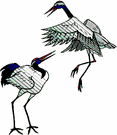Today a major spring storm hit much of Colorado with a variety of rain, snow, and wind. The high elevations in southeast Colorado got the snow but most of us just got the rain and wind. As the winds were cranking in from the southeast, I went out this afternoon to see what might have been brought in by this storm. On the east side of Canon City I saw a flock of about 75 Franklin's Gulls beginning a flight up the Arkansas River at low elevation, possibly in order to feast on insects flying just above the water (yes, this species of gull eats insects).

On Florence River road (local name for the road nearest and parallel to the Arkansas River), there was a flock of White-faced Ibis (quite possibly the one I posted on yesterday). Though they were in the same field that the Ross'Goose was located, I didn't see it today. A ways down the road I found the first Great-tailed Grackles that I have seen in this area this season including the male bird in this pic. Though quite common in many southern states, these are still a bit of a novelty in many parts of Colorado.

I also found the first Yellow-headed Blackbirds of the season here, shown in the lower pic with their strange feed-fellows (yeah a play on words on "strange bed-fellows"). Actually, Yellow-headed Blackbirds and as well as other members of the blackbird family are quite common around dairy cows such as these and other cattle.
There were some Mountain and Western Bluebirds near Brush Hollow Reservoir but surprisingly no waterfowl or waterbirds. Two Turkey Vultures loafed on the shore like two grounded teenagers.
And I was surprised to find a light morph adult Ferruginous Hawk at the far eastern parking lot for the Canon City Riverwalk. These are birds of more open grassland areas so it may have been blown in by the gusty easterly winds.
Labels: Ferruginous Hawk, Great-tailed Blackbirds, Yellow-headed Blackbirds


























































